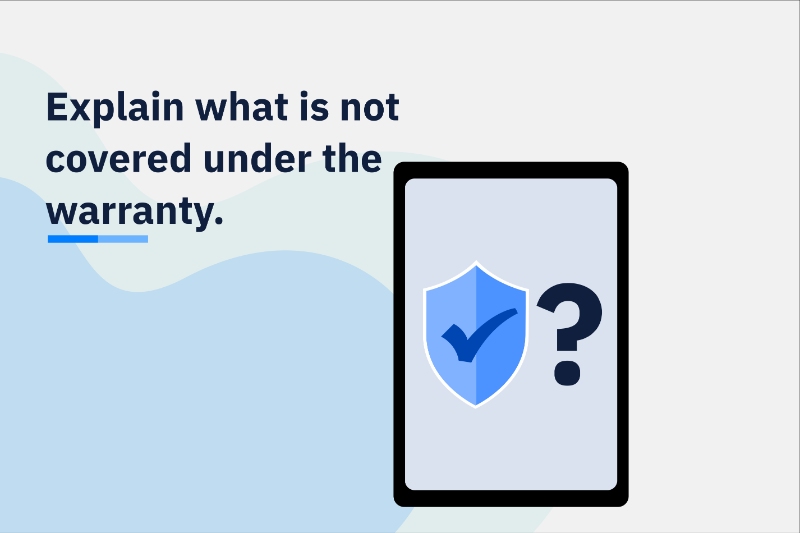
If you are interested in making your products look trustworthy to consumers, then product warranties may be something you should consider.
Most successful brands have a warranty policy that they offer goods or services. Offering your customers a product warranty policy helps build customer confidence and loyalty, increase brand recognition, and it sets you apart from your competitors.
It's important to provide warranties for your products if you want consumers to feel confident about buying them. In this article, we'll walk you through the complete and the only guide you need to create a product warranty policy for your brand.
Contents
- Consider your competition before creating your warranty policy
- Set a duration for your product warranty
- Explain what is covered under the warranty
- Clearly define what isn't considered a defect and won't be fixed for free
- Create a customer support policy
- Invest in a warranty management software
- What should be your next step?
Identify your legal requirements before creating your warranty policy

Before you begin writing, check your state's legal requirements for warranty policies. In some cases, your warranty policy may need to be approved by a lawyer. In other cases, you may only need to ensure that it complies with federal and state warranty laws. If you are unsure of your state's requirements, consult a lawyer or a government agency for guidance. Also be sure to look into any industry-specific rules.
Once you have identified all the regulations that apply to your business, examine each one closely. Read them carefully and highlight any important details that come up repeatedly in different documents. You’ll use this information when writing your policy, so make sure it's accurate and up-to-date.
Consider your competition before creating your warranty policy

Let's be honest: the competitors in your market are doing basically the same thing you are. They're selling to a similar audience and offering similar products, so it's natural for you to want to do things a little differently. In fact, it's important that you do things a little differently! If you don't, you'll likely end up losing business to someone with a more appealing product warranty policy.
One of the best ways to differentiate yourself from your competition is to offer a longer warranty period than they do. If everyone else offers warranties of only one year on their products, consider offering two years instead—or even three or five! This will allow potential customers to see that they can get more value from your products than they can from anyone else's.
If you're worried about not being able to afford this type of product warranty policy, remember that it doesn't necessarily have to cover every single product you sell. You could opt instead to offer different types of warranties based on the type of product it is and its retail price.
Set a duration for your product warranty

This is pretty straight forward - you need to think about how long your product should be covered by the warranty. If you're not sure, it's always best to give too much coverage than not enough. Consider what kind of material your products are made from, how long they are expected to last, and what kind of durability tests were performed during manufacturing and development stages. The better the quality of your product, the less need there will be for repairs or replacements due to defects. However, when in doubt, give yourself some leeway so that if any problems arise after the intended lifespan has expired, you can still provide coverage without losing money on the deal
Explain what is covered under the warranty

When you're considering what to include in your warranty, be sure that the coverage is clear, and that it's clearly stated on the packaging. If you're selling a product with multiple components, it's important to be clear about how the warranty applies to each.
The more complicated the technology of your product is, the more complicated its warranty will likely be. It's important for consumers to understand exactly what's covered in case of malfunction. If there are any stipulations—for instance, if a warranty applies only when the product has been used in conjunction with a specific component—be sure to make that explicit.
The consumer needs to know exactly what the warranty covers. For example, you may offer a one-year warranty that covers all parts and labor, but only if the product was used in accordance with its intended purpose. If you sell a product that is meant to be used indoors, but the consumer left it out in the rain, and it broke, then you would not be responsible for fixing it.
Clearly define what isn't considered a defect and won't be fixed for free

As you're creating your warranty policy, be sure to set some boundaries for what is and isn't covered. If you sell something that's prone to damage from lots of use—like a car, washing machine, or kitchen appliance—you'll want to establish up front what kind of damages aren't considered defects by your company.
For example, if the motor in a blender breaks after a year because it was used daily for four hours a day, that probably isn't a defect—but if the motor breaks after only three months of intermittent use because the blades weren't properly aligned and the blender was shook when it was turned on (read: user error), that's probably a defect.
Knowing which damages are definitely not defects can help you avoid being taken advantage of by customers who want something for nothing, but also helps you avoid looking unreasonable when a customer has to pay for repairs that they feel should be covered under warranty. Make it clear what won't be fixed without charge so you can build trust with your customers.
Create a customer support policy

When you create your policy, include a clear explanation of how your customers can get support for their issue. Providing phone numbers and email addresses will help them feel as though they can reach you directly if they need to. It's also a good idea to explain how long it will take to receive a response. You should provide realistic estimates rather than promising a rapid turnaround time that you can't deliver.
If you want to set up a good customer service experience for your customers and make good on the promise of a product warranty, make sure you:
1. Provide multiple ways for them to get support
2. Give customers an estimate of how long it will take for them to receive a response
3. Use available feedback mechanisms so that you can improve your customer service
Invest in a warranty management software

Warranty management can be a daunting task for any company. All too often, managing warranty information is an ad hoc process that relies on the memory of a select few employees. This typically leads to inconsistent customer service, longer repair cycles, and expensive warranty costs. The good news is that by investing in a warranty management software like NeuroWarranty, your company can avoid these pitfalls and improve overall customer satisfaction.
Warranty management software will enable you to:
- Track every warranty claim from start to finish
- Keep a history of past claims and repairs
- Identify potential problems with products and services before they become widespread issues
- Determine which warranties are worth pursuing and which ones are not
- Provide better customer service to your clients
- It's not hard to create a warranty policy that will work for your business.
Creating a strong warranty policy not only increases your repeat sales but customers will also be less hesitant to try your product in the first place.
What should be your next step?
Now that you have formulated a strong warranty policy for your products, you would need an easy to use process to help your customers claim, and help you manage warranty claims. To know how NeuroWarranty can help you automate your warranty claims management click here.


